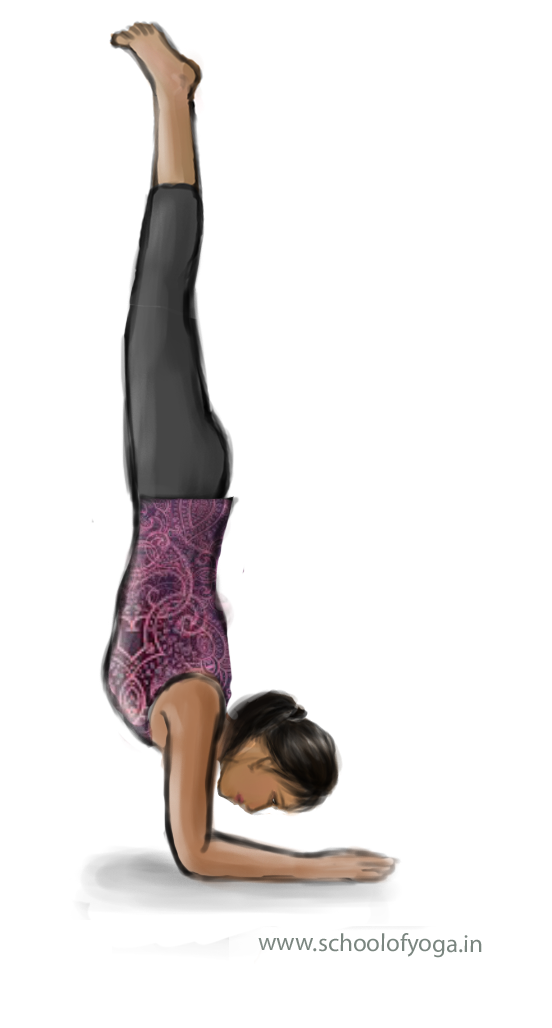School of Yoga explains Pincha mayurasana (Feather Peacock Pose)

Pincha mayurasana technique: (Should be learned under supervision of an advanced practitioner)
- Sthithi (starting) pose: Spread a thick cloth pad against a wall. Kneel in front of the pad.
- Bend forward and place hands on the spread to form a “V” at an angle of approximately 60 degrees. Also, the palms should be turned facing the body with fingers interlaced.
- Place the top of the head close to the cradle of the interlaced hands so that the palms touch the back of the head.
- Raise the legs so that the torso begins to get vertical from the ground. Bring the legs close to the body.
- Lift one leg and leveraging with elbows, shoulder and lower back muscles, then launch the other leg off the ground smoothly.
- Bend the knees so that the torso is balancing on the 2 forearms and the weight of the body is anchored in the muscles of the shoulder and shoulder blades.
- As the torso rises, keep knees together. Get into an upside down position.
- Straighten the hands using the shoulder and arm muscles.
- The body should be held straight in the final position.
- Maintain normal breathing. Focus on the movement of breath at the throat.
- Stabilise position and straighten the legs.
- After sufficient practice one could begin doing this exercise away from a wall. In this case after lifting the legs off the ground, fold them at the knees square to the body for balance.
- Start with 10 secs. initially. Normal cycle is 3 to 20 minutes. Descend in reverse order, slowly.
- The drishti (gaze) recommended is Oordhva drishti (open sky gaze).
Pincha mayurasana benefits
- This asana infuses oxygen pregnant blood into the central nervous system. As a result, brain cells are invigorated, waste cleaned and removed. The oxygen stabilises the brain’s metabolic activity. Therefore, this exercise is good for behavioural and psychological development.
- The eyes, eye muscles, retinal nerves are flushed with oxygen impregnated blood. Hence, very good for health of the eye.
- This asana energises the pituitary glands, hypothalamus and thalamus which controls the functioning of testes in men and all the endocrine organs such as the thyroid and adrenaline glands.
- The downward force of blood also helps in infusing blood to the ears, eyes, mucous tissues and salivary glands. Also, the throat breathing balances ear pressure.
- Good for maintaining body fat balance since pituitary also regulates the balance between water and salt in body fluids through the kidneys.
- Since the weight of the body is not carried by the cervix but by the shoulders, this asana rejuvenates the cartilage and muscles in the spine and the sympathetic and parasympathetic nervous system.
- The muscles of the back get strengthened.
- Finally, the downward pressure of the colon contents increases peristalsis and cures constipation.
Pincha mayurasana contraindications:
- People with heart or circulatory ailments should not practice this asana.
- This asana should not be practiced by people suffering from arthritis, hernia and back problems.
- People with eyes, lungs, liver, kidney related illnesses must perform this asana only under supervision of a physician.
- Do not perform this asana during menstruation or pregnancy.
Some noteworthy points on Pincha mayurasana:
Internal Links: Dharma (conditioning), Stress and Situational Awareness, Prana, Asana overview 1, Asana Overview 2, Asana Focus or gazing, Pranayama, Yama, Niyama, Shirasanana, Mayurasana,
External Links: Prana, Chakra, Pancha Tattva, Pancha Prana, Pancha Kosha, Nadi,
- First, this asana requires a lot of preparation and must not be attempted by a novice. Second, if you are over 40, do not start this asana unless you are completely fit with a history of physical activity. Third, if you have blood pressure or circulatory issues, with ENT (eyes, ears, nose or throat) problems, history of obesity, shoulder and neck ailments, do not practice this asana.
- In the beginning, this asana can be very difficult owing to the resistance offered by the hip-joint and inability to bend forward. Therefore, it is important to remember that any progress will come over time.
- Do not relax the abdomen. It can cause the walls to collapse and tearing of the inguinal hernia.
- Unlike Shirasasana, where the load distribution is a stable 3 point system, in this asana, the loading is 2 point without the benefit of the head for stability. Hence, it is important that the following preparatory asanas are practiced;
- Practice Shirasasana and be able to hold the pose for 5 minutes
- Mayurasana should be practiced to strengthen the wrists and forearms.
- Start Pincha Mayurasana against a wall until able to hold the pose for 2 minutes.
- Slowly try to perform this asana without help of the wall.